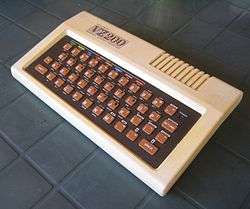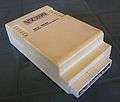VTech Laser 200
 The VTech Laser 200, rebadged as a Dick Smith VZ200 | |
| Manufacturer | Video Technology |
|---|---|
| Type | Personal Computer |
| Release date | November 1983[1] |
| Introductory price |
$99USD £98GBP |
| Discontinued | 1985 |
| Units sold | 200,000 in Australia |
| Media | Cassette tape, Disk drive |
| Operating system | BASIC V2.0 |
| CPU | Zilog Z80A clocked at 3.58 MHz, Motorola 6847 video processor |
| Memory | 6-22KB USER-RAM + 2KB VRAM, 16KB ROM |
| Display | 32×16 (8 colors), 128×64 graphics (2 background, 3 foreground colors) |
| Input | 45 key Keyboard |
| Power | 10 volt |
| Dimensions | 29 × 17 × 4cm |
| Weight | 800g |
| Predecessor | VTech Laser 110 |
| Successor | VTech Laser 310 |
The VTech Laser 200 was an early 8-bit home computer from 1983, also sold as the Salora Fellow (mainly in Fennoscandia, particularly Finland), the Seltron 200 in Hungary and Italy, the Texet TX8000 (in the United Kingdom), and the Dick Smith VZ 200 (in Australia and New Zealand).
The machine ran basic games on cassette such as "Hoppy" (a version of Frogger), "Cosmic Rescue" (Scramble), "VZ Invaders" (Space Invaders) and Moon Patrol. The Laser 210 / VZ200 computer was discontinued in 1985.
Release
The VZ200 had little impact in the UK where it sold at a similar price to the 16 kB Sinclair Spectrum and in USA where a Timex TS1000 could be bought for $30. It gained a measurable following in other countries where it was supported by the distributor and where Sinclair Research was too disorganised to have any impact. It gained some following in its native Taiwan, in Australia and New Zealand, and in some countries in continental Europe.
At its UK launch, Texet claimed that the £98 TX8000-branded version was the cheapest colour home microcomputer on the market. However, this was not enough to ensure its success against the dominant ZX Spectrum and similar machines already on sale.[2]
The "Dick Smith"-badged VZ 200 was more successful in Australia, where it proved popular as a first computer.[3]
An improved version known as the VTech Laser 310, or the Dick Smith VZ 300 featured a full travel keyboard and 8K ROM software based Floppy Disk Controller, was released in 1985 and continued until 1989.[4]
Technical specification
The VZ200 was designed and built by Video Technology (VTech) in Taiwan. It appears to be inspired by the Sinclair ZX-81 as it has the same type of one key commands but has some extra features, namely, 6 kB of RAM (ZX-81 had just 1 kB), redefinable characters (with the ZX81 you were stuck with those supplied), a bitmapped mode allowing block by block animation (the ZX81 only had character movement) and beeper speaker (the ZX81 was silent).
Based on a Zilog Z80A CPU driven by a television colour burst crystal (3.5795454 MHz) (in PAL, NTSC and Secam), it offered 16 KB of ROM containing Microsoft BASIC Level II, 8 kB RAM (2 kB for video memory) for the PAL model, whilst the NTSC and Secam models had 6 kB RAM (2 kB for VRAM) and eight colours.
Text mode had 32 x 16 characters and there were two bitmapped modes : 32 x 64 addressable blocks in eight colours and 32 x 128 addressable blocks in four colours. The total number of pixels was 256 x 192.
Because there is only 2 kB of VRAM, only one of the video display modes of the MC6847 Video Display Generator (VDG) chip is available, effectively disabling the bitmapped higher resolution 256×192 mono colour mode. There were a few unofficial "mods" developed that increased the VRAM and enabled the 256×192 mode that the MC6847 was capable of, a number of programs were written (mainly) by German user groups that used this particular modification. Rather crude sound effects could be achieved by a built-in push/pull piezo speaker via its BASIC, though 1-bit synth and sampling sound can be produced through both raw Z80 assembly as well as libraries within the Z88 Development Kit.
The BASIC interpreter used Microsoft Level II BASIC (similar to IBM PC BASIC A).
Laser 310 / VZ 300
The Laser 310 was released in 1985 throughout parts of Europe and the United States. It was named and sold as the "Dick Smith" VZ 300 throughout Australia and New Zealand. Also based on a Zilog Z80A CPU with a slightly updated 16k ROM version, it was driven by a television colour burst (3.54 MHz) crystal. It came with 16k of RAM for programming, along with the same 2k of Video Ram as that of the Laser 200.

Peripherals
Within a year of the Laser 310's release, an 80k disk drive unit was released on to the market, of which two could be connected to the computer at the same time. A plug-pack cartridge containing the DOS ROM was required to operate the drives. The DOS ROM and diskette drives were backwards compatible with the Laser 200. A number of other VTech designed plug-in peripherals were also available for both the Laser 200 and Laser 310 computers. Among them were joysticks, cassette drive, light pen, printer plotter, 75 baud MODEM, word processor cartridge, and the 16k and 64k extended RAM cartridges. As numbers of users grew, so did the number of home-made kits which were on offer, which included a Speech synthesizer, SN6847AN music synthesizer, EEPROM programmer, data logger, 300 baud MODEM, full 101 keyboard, and a RTTY Ham radio kit.

Software
With both of their releases in Germany, England, USA, Italy, Australia, New Zealand and a few other countries, commercially based software titles grew and were distributed throughout various outlets in their home countries. Throughout Germany, Sanyo distributed a number of high quality software graphics, cassette and disc utilities. The Big W and Dick Smith Electronics store fronts throughout Australia and New Zealand sold many titles, including educational and graphical games, finance programs and various software utility tools, most of which have been found and transferred for the use in the various emulators. Unfortunately there are a number of known software packages that have simply been lost through the age of time.
Emulators
A number of emulators have since been written for these models of computers:
Gallery
 The back panel of the VZ200
The back panel of the VZ200 The optional 16 kB RAM expansion
The optional 16 kB RAM expansion A VZ200 in operation
A VZ200 in operation Inside the case of a VZ200
Inside the case of a VZ200 VZ200 with additional RAM plugged in
VZ200 with additional RAM plugged in VTech Laser 310 with keyboard template and cassette deck
VTech Laser 310 with keyboard template and cassette deck A rare Laser 305 computer
A rare Laser 305 computer
References
- ↑ Video Technology LASER 200 / 210 OLD-COMPUTERS.COM Museum
- ↑ Bennett, Bill, Texet TX-8000 review Archived 2004-05-15 at the Wayback Machine., Your Computer magazine, April 1983. Retrieved 2007-03-21.
- ↑ Dick Smith VZ-200, thepcmuseum.com. Retrieved 2007-03-21.
- ↑ Video Technology Laser 310, old-computers.com. Retrieved 2007-03-21.
External links
| Wikimedia Commons has media related to VTech Laser computer. |
- DSVZ200 - VZ200 emulator
- VZEM by Intertek - The official homepage of the VZEM emulator
- JEMU - Java based VZ200 & VZ300 Emulator
- A contemporary review - from Your Computer, April 1983
- Laser Beams In At Just £70 - from Personal Computer News, August 18 1983
- The VZ200 - Tutorials and Programming
- A VZ200 Wiki - Information
- Clockmeisters VZ/Laser310 page
- German VZ dedication page with 600+ German VZ software titles.
- Bushy's Absolute everything VZ page.
- Steve's VZ page.